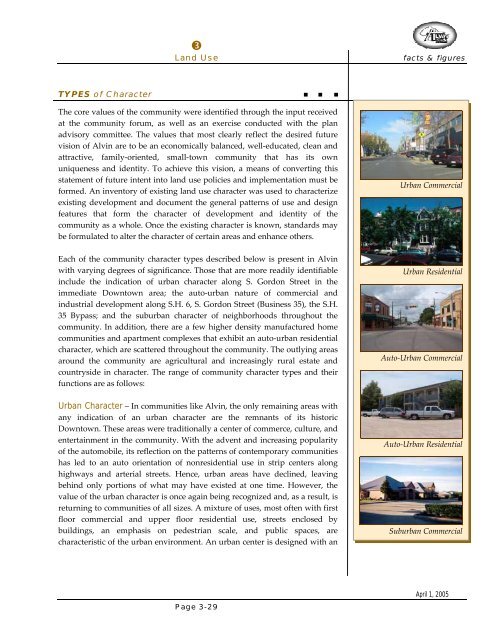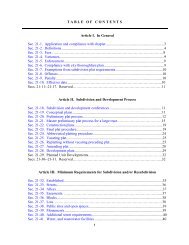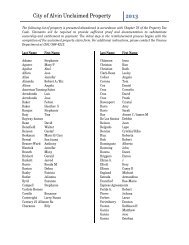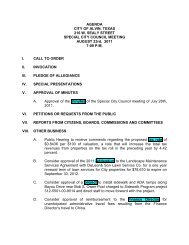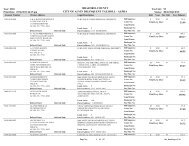Comprehensive Master Plan - City of Alvin
Comprehensive Master Plan - City of Alvin
Comprehensive Master Plan - City of Alvin
- No tags were found...
Create successful ePaper yourself
Turn your PDF publications into a flip-book with our unique Google optimized e-Paper software.
Land Usefacts & figuresTYPES <strong>of</strong> Character • • •The core values <strong>of</strong> the community were identified through the input receivedat the community forum, as well as an exercise conducted with the planadvisory committee. The values that most clearly reflect the desired futurevision <strong>of</strong> <strong>Alvin</strong> are to be an economically balanced, well‐educated, clean andattractive, family‐oriented, small‐town community that has its ownuniqueness and identity. To achieve this vision, a means <strong>of</strong> converting thisstatement <strong>of</strong> future intent into land use policies and implementation must beformed. An inventory <strong>of</strong> existing land use character was used to characterizeexisting development and document the general patterns <strong>of</strong> use and designfeatures that form the character <strong>of</strong> development and identity <strong>of</strong> thecommunity as a whole. Once the existing character is known, standards maybe formulated to alter the character <strong>of</strong> certain areas and enhance others.Urban CommercialEach <strong>of</strong> the community character types described below is present in <strong>Alvin</strong>with varying degrees <strong>of</strong> significance. Those that are more readily identifiableinclude the indication <strong>of</strong> urban character along S. Gordon Street in theimmediate Downtown area; the auto‐urban nature <strong>of</strong> commercial andindustrial development along S.H. 6, S. Gordon Street (Business 35), the S.H.35 Bypass; and the suburban character <strong>of</strong> neighborhoods throughout thecommunity. In addition, there are a few higher density manufactured homecommunities and apartment complexes that exhibit an auto‐urban residentialcharacter, which are scattered throughout the community. The outlying areasaround the community are agricultural and increasingly rural estate andcountryside in character. The range <strong>of</strong> community character types and theirfunctions are as follows:Urban ResidentialAuto‐Urban CommercialUrban Character – In communities like <strong>Alvin</strong>, the only remaining areas withany indication <strong>of</strong> an urban character are the remnants <strong>of</strong> its historicDowntown. These areas were traditionally a center <strong>of</strong> commerce, culture, andentertainment in the community. With the advent and increasing popularity<strong>of</strong> the automobile, its reflection on the patterns <strong>of</strong> contemporary communitieshas led to an auto orientation <strong>of</strong> nonresidential use in strip centers alonghighways and arterial streets. Hence, urban areas have declined, leavingbehind only portions <strong>of</strong> what may have existed at one time. However, thevalue <strong>of</strong> the urban character is once again being recognized and, as a result, isreturning to communities <strong>of</strong> all sizes. A mixture <strong>of</strong> uses, most <strong>of</strong>ten with firstfloor commercial and upper floor residential use, streets enclosed bybuildings, an emphasis on pedestrian scale, and public spaces, arecharacteristic <strong>of</strong> the urban environment. An urban center is designed with anAuto‐Urban ResidentialSuburban CommercialPage 3-29April 1, 2005


